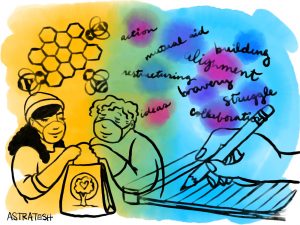“Beyond the Page” digs into the process and practice of writers and artists who work at the intersection of literary arts and other fields. This interview is the first of three with interdisciplinary artist Udita Upadhyaya about “nevernotmusic” — a solo exhibition of scores activated by curated, collaborative performances — and her process of developing these scores into a book (read the second interview here and the third here). In early March, on the last day of her show “nevernotmusic” at Roman Susan, I met with Udita to discuss her processes of creating and “gifting” performance scores, transforming the scores into an installation, and learning from performers’ interpretations.
Follow @uditau on Twitter and Instagram and check out her book launch at TriTriangle on September 8, 2018, at 7pm. This interview has been edited for length and clarity.
Marya Spont-Lemus: Knowing a bit about your work, and specifically your work with language, I already wanted to talk to you for “Beyond the Page.” And then I was so excited to hear about “nevernotmusic” — the exhibition and the eventual book you’re thinking of making with the scores. So thank you for speaking with me about both!
Udita Upadhyaya: Thanks for chatting, and for being so excited about “nevernotmusic” with me! What I liked about the interview I read was that it felt like just a conversation, but because you knew the person it felt like you could get to the meat of the conversation. I want to hear about other people’s processes but nobody’s really talking about them, so that adds to the mystery. I don’t know, I was thinking about it before I started making art, because I would be like, “How do you do it?” “How do you know when a thing is done?” “How do you know when it’s a series?” “How do you know what you’re doing?” And there was nothing, or barely anything, that I would find that was generous and actually sharing what it meant to be an artist every day, for a really long period of your life. So I did appreciate the…the intimacy, that gave you the permission to do that.
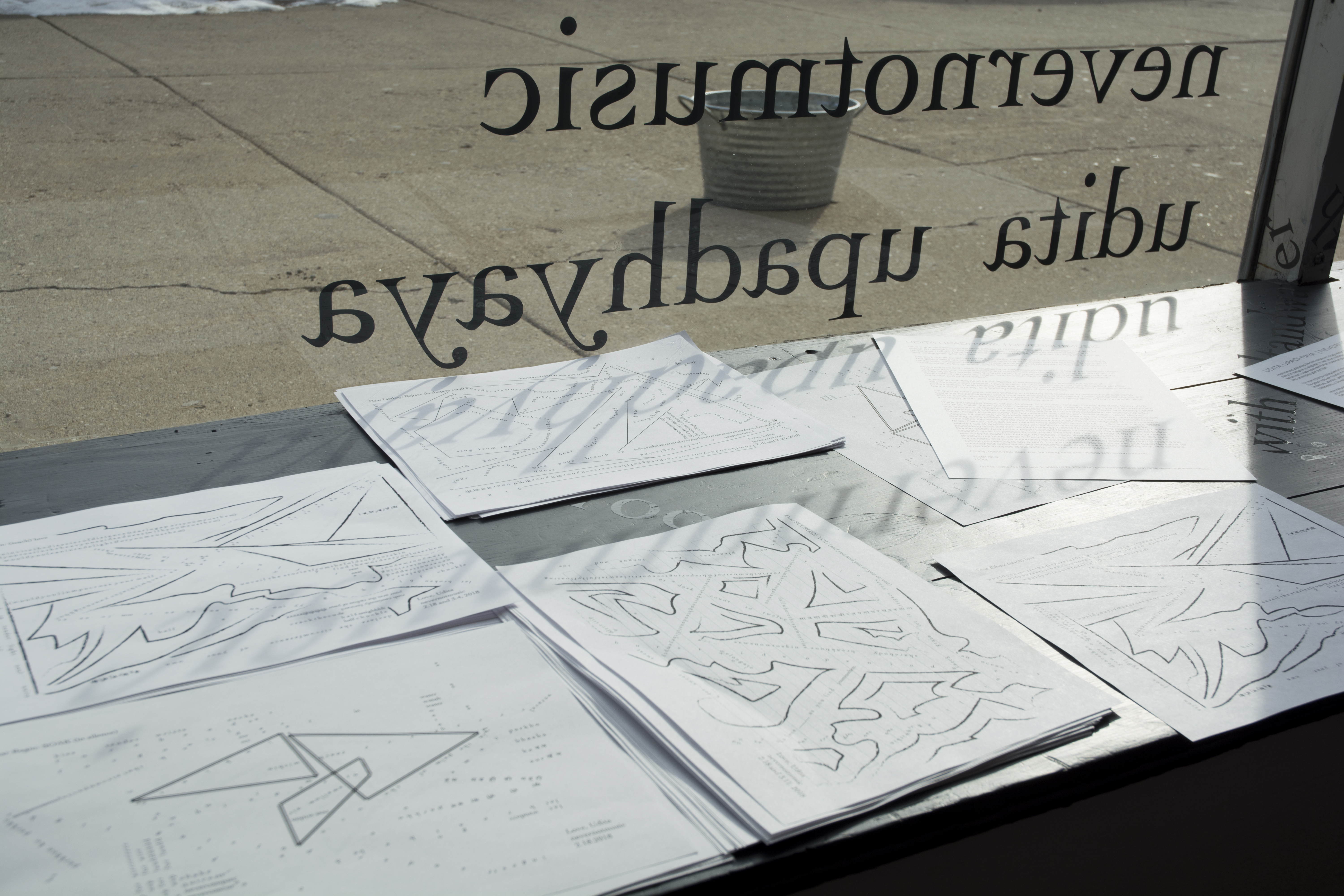
MSL: Well, I’m glad you read that into it, because everything you just said was a lot of my other interest in the series and what I was hoping people would get out of it. Because while I know that they are longer interviews, I think there’s a place for the five-question interview that fits in a post or on one page of a newspaper and there’s a different level of depth and detail that I myself find really useful.
UU: Yeah, the series feels like it is for artists. From the one thing that I’ve read. I’m happy to be a part of it. Ahh! [both laugh]
MSL: So I’m thinking it might be helpful – while in this space – to talk in relation to your show that’s up now, on its final day of performances, especially anticipating that we may have more conversations as the book develops.
UU: Yeah. The book was not originally part of the plan. But it would involve the same scores as this show — here they are printed. Feel free to look at them.
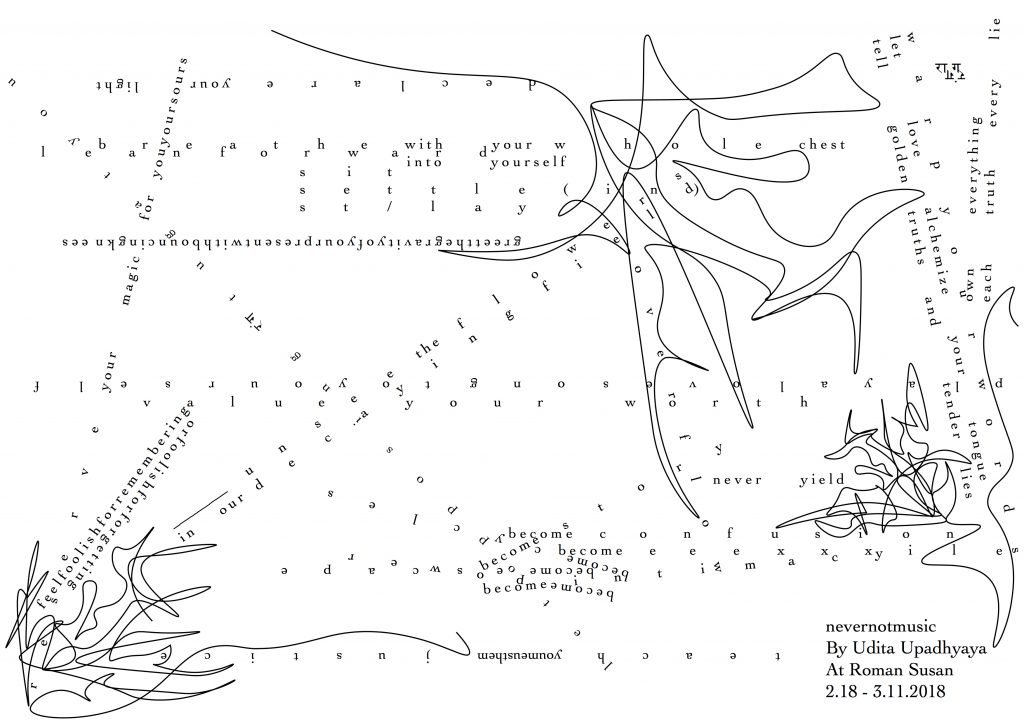
MSL: You know what, I printed them out this morning to bring with me – but I always print everything on used, one-sided paper – and I thought you might be amused to see that a couple of them accidentally got printed over double-sided content. [laughs] So here are your scores overlaid on W-9 forms and other things.
UU: Oh! I love that!
MSL: So I don’t know if you want to keep them as your own humorous record, but these are a new level of accidental score.
UU: Maybe. Yeah, actually! I do. It’s funny, there’s all of these accidents that happen. If you look up here — [points at wall] I took a picture of this and put it on Instagram the other day — it says “familiar darknesses.” But the way the “r” and the “d” meet, it looks like a half-“n” and “d,” right? And that’s actually how Hindi (the devanagari script) works. Hindi has a lot of half-alphabets. Like it just clicked for me, this is kind of partly where it’s coming from for me, without really recognizing it. My software doesn’t allow me to do Hindi the way that I would, but a lot of times in Hindi if there’s a word that has a half-sound, like a softer “n” sound or softer “t” sound, literally you write half the letter. It’s so weird and beautiful. And the “r” and “d” so close to each other on the wall look like half of that. So I’m really excited about your accidental score here because I keep finding these crazy beautiful things that I’m geeking out on. Accidental, fun things. So thank you.
MSL: Yeah. [laughs] Hopefully it feels interesting and not disrespectful of your work.
UU: No, it’s not disrespectful at all. It’s very interesting.
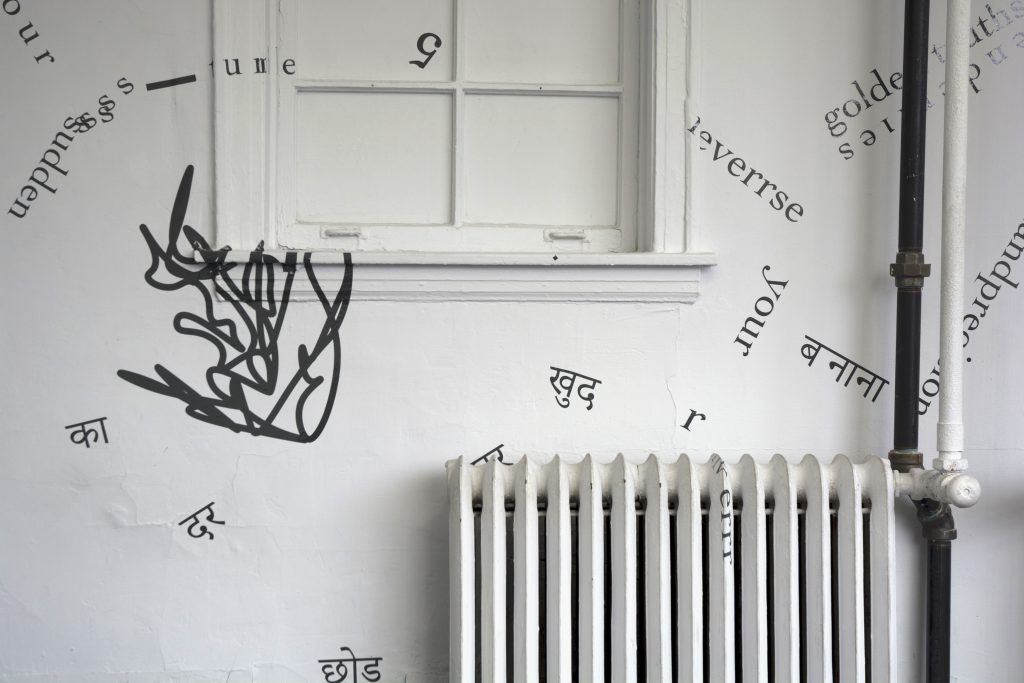
MSL: Right before we sat down, you were starting to say a little about how you work and the periods of gestation and intensely detailed production and that sort of thing. And I guess I’m interested to hear — particularly using this show as an example — how you build your work, and who builds your work, and how it becomes this thing.
UU: Yeah! This is a great example because I think I always have thought of it as “the work builds itself,” in a way that’s both freeing and exhausting, you know?
I originally started out making scores because I was trying to give my body a break from the exhaustion of performance, especially when it’s performance in the context of my brown, female, queer, foreign body. And the scores ended up being both — at the beginning — tongue-in-cheek play on fact/fiction but also ways to see my body more than you would ever. So the score that I’m talking about, that started it out, is called “An Inventory: Remnants from a constellation of lived performances,” and it’s basically a lyrical-medical biography where it’s telling you all of these things not just about the insides of my body but both my parents’ bodies — I’m an only child. It starts out with this feeling of disinheritance and with how my mom and I felt when my dad had a heart attack — but all of these things that you won’t see if you see his body. Like you don’t know what’s going on. Similarly, I think, more importantly, it was about my body and what I get from them. Like, I have male-pattern baldness. I’m not male. I have this really weird thing that is inside of my eye that happens to 18-year-old boys that happened to me when I was 16 and is something that will eventually go away but is something I have to go to the doctor for all of the time. And in those moments I felt like race was coming in but in a more complicated way than if my body was just present and you were just seeing the outside of it. And then I also felt like I could, by recreating my body more intimately, add nuances to what-you-see-when-you-see-me versus who-I-actually-am kind of feelings that I was really struggling with early on in my Chicago life.
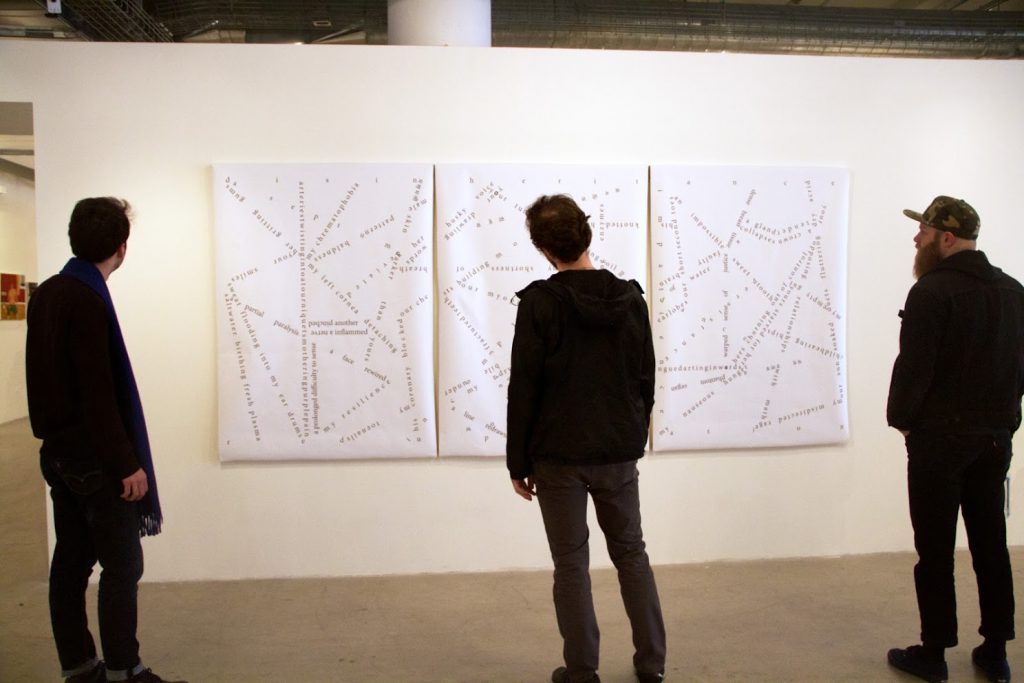
I found other ways to deal with that too, which is why I continued to perform. Part of working with Lindsey — my frequent collaborator, and dear friend, Lindsey Barlag Thornton — is that her work allows me to make the work that I would make if I could just be a person. [laughs] You know, and be more than an “exotic” foreign body. And I am a brown person! There’s no denying that. But I’m also a brown person with extreme privilege, and I’m not interested in hiding that privilege. I’m interested in talking about that privilege. I’m kind of annoyed by the moments where I have to push back and be like, “I have a lot of privilege. I’m from a country that’s very messed up in terms of caste, in terms of class, in terms of all of these things. My narrative is not as simple as you’re trying to make it be when I’m working with a sari in front of you.” Like, me working with a sari is very different than the person who actually wove the sari with their hands. And so the scores were trying to bring some complexity while also trying to give myself a break from being in front of an audience and being seen this way where I felt like I was losing agency. That’s a thing I think about a lot when making performance work. I need to navigate agency and how much of it I’m willing to give up and how much — that play.

So I applied to Roman Susan to do the same kind of score as “An Inventory,” but I was really excited by what happens when someone’s reading a score that is my body but their body is like a white, male, six-feet-tall, lanky body — this is a specific friend who performed here. So I wrote to them — to Nathan Smith and Kristin Abhalter Smith, who run Roman Susan — being like, “I’m going to write a score and then these four or five people are going to respond to it.” And then by the time the show started to happen, both personally and politically a lot had come to pass. There was too much shock and despair and it had been a really long year since November 2016. It feels really long. [both laugh] So I feel like I started to make work that was trying to give moments of goodness within the complexities of what it means to be in the world that we’re in. I think of it as goodness, but not glossing over the realities. It’s very much goodness despite. There’s something of grounding. So, with the scores, I was less interested in my body or my personal being at the center of it. I was more interested in gifting, and gratitude, and generosity. And then we scheduled it for the winter, so that became another layer of “oh my God, we’re going to need each other, we’re going to need hugs, we’re going to need touch, we’re going to need sun!”
MSL: Heat in the space!
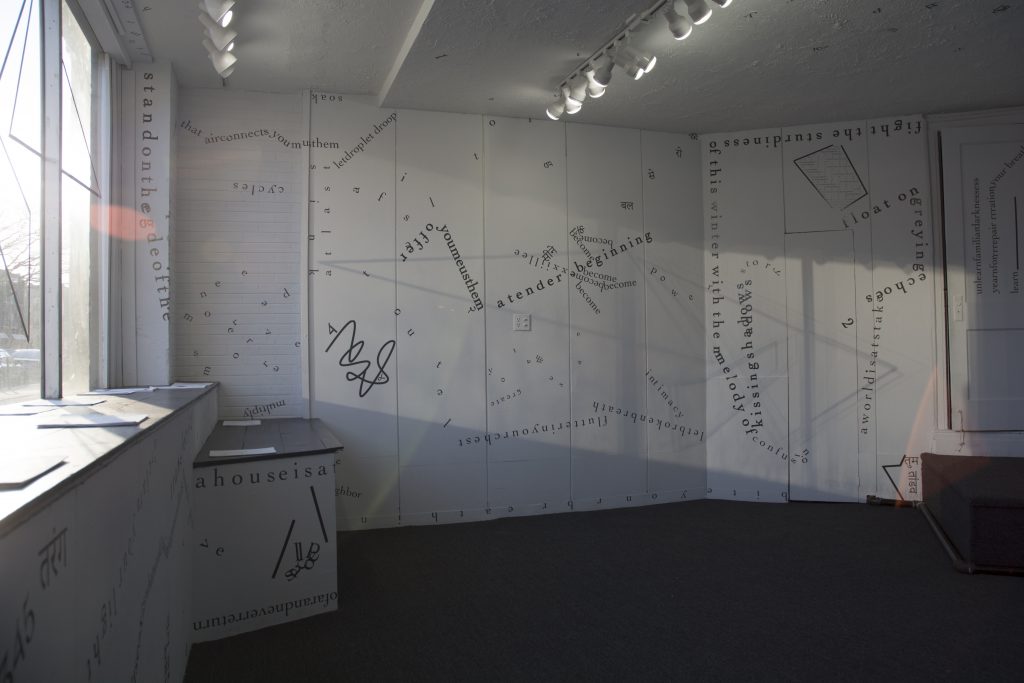
UU: Heat in the space! Yeah. And then over the period of the months that I was thinking of the project, the original four people, who were all still in it, became 12. Which, of course, is the part of my process that I wish I had more control over because I was like, “This is getting really big, this is getting really big, this is getting really big….” And I was really excited about all of the 12 groups, made up of 17 artists, but I did have to have a moment where I was like “12 is a good number, stop. Stop.” Making that call. And I thought that they would be scores that are very simple and fluxus — like “do this, do this, do this.” I’ve worked in that format before and it’s been really fun. But because the 12 groups that I was working with I was so excited about — and we did so many meetings together and we had conversations about “What are you thinking and feeling? What do you need right now? What’s going on?” — the scores ended up being really elaborate love letters for each person, you know? And that’s also where I feel like the work took over.
I think the first score that was finished was Corey [Smith]’s score. In a way it was the easiest because he was super busy and we hadn’t really been able to spend time together much. I just know him really well — he had just finished a big show and I knew what was going on in his life — so I was coming at it from a knowledge that was more…open? And specific. But still, at the same time, not “of” the time in the way that, for example, the second score that will be performed today. This one is very specific in what this person’s going through right now. So it was actually harder to write! So it was this weird mix of, basically, my relationships with each of these people or groups of people and varying levels of difficulty, sort of trying to do the emotional labor for each friend.
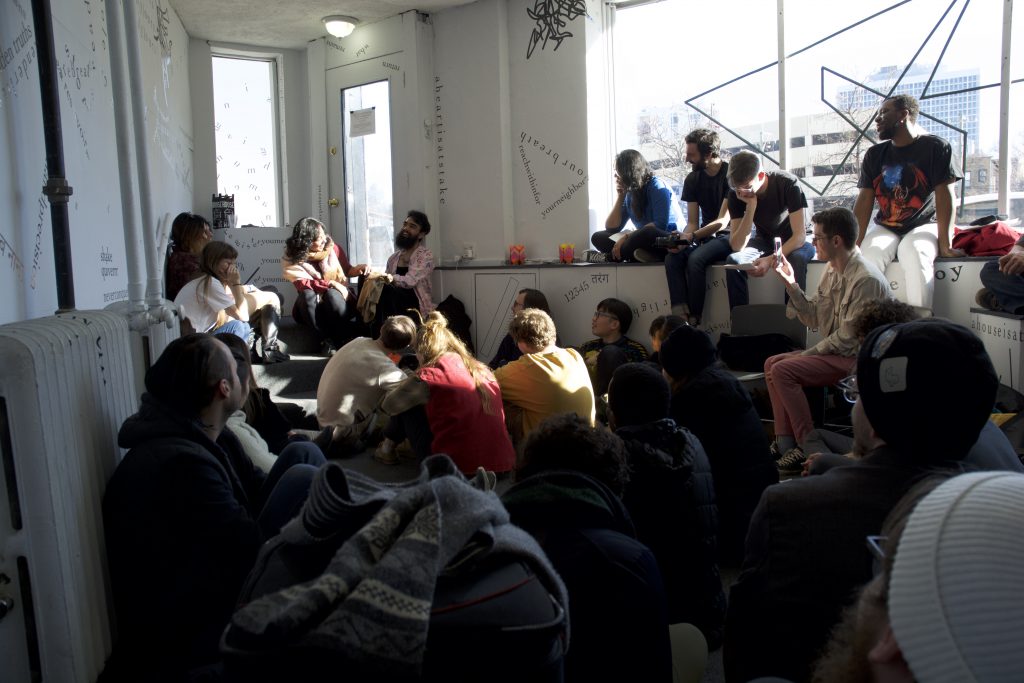
And the one score that I’m looking for right now [sifts through the physical scores] — that was actually really lovely, the performance was really beautiful…this one — this was the one where I found that these were also love letters. Because this is for Falak [Vasa], who is ten years younger than me — we’ve collaborated a bunch — also from India, queer, non-binary, young human is how I think of them. And they were having a really hard time. And I was writing a score for them and all I wanted to do was say, “You’re beautiful and I love you!” And I was like, “How do I say that in a score? What are they going to do with it? And that’s not what they’re thinking of, that’s just what I want to say to them.” There’s literally like, [pointing to score] “You are…” Okay, it doesn’t say “beautiful.” [Marya laughs] But “You are permission and precision.” “You are a dhun unraveling.” Which is like a song, a dhun (in Hindi) is like a tune…unraveling. So it became a lot of “You’re going to be okay. I see you. I love you.” Things that — in some scores, specifically, because of what those people were going through in their lives — ended up becoming very “I see you and I love you.”
Falak’s score is called हम or “hum” but in Hindi, which makes it super layered with meaning. Yes, to hum, in English, is well within the themes of “nevernotmusic” — finding music everywhere, finding the joy and vibration of music even without looking for it, even when you are running away from it. But “hum” in Hindi is “we” or “us.” I was trying to say, “You are not alone,” “I am in this with you.” “Hum” in Hindi is also how one would use gender non-binary pronouns, something that Falak and I were talking about, annoyed with how hard it is to hold non-conformity in conversation, given grammar in our mother tongues, Hindi and Gujarati…it was an additional layer or acknowledgement.
And then there was — I think in this score — there was “Dear Ethan, you are a young old tree truth glorious sprawling…” and it rambles on with goodness. You know, all of these things that were moments of tenderness that are not score-like and not instructional at all, they’re just gifts. And then I really started enjoying it. Yeah. It was just fun.
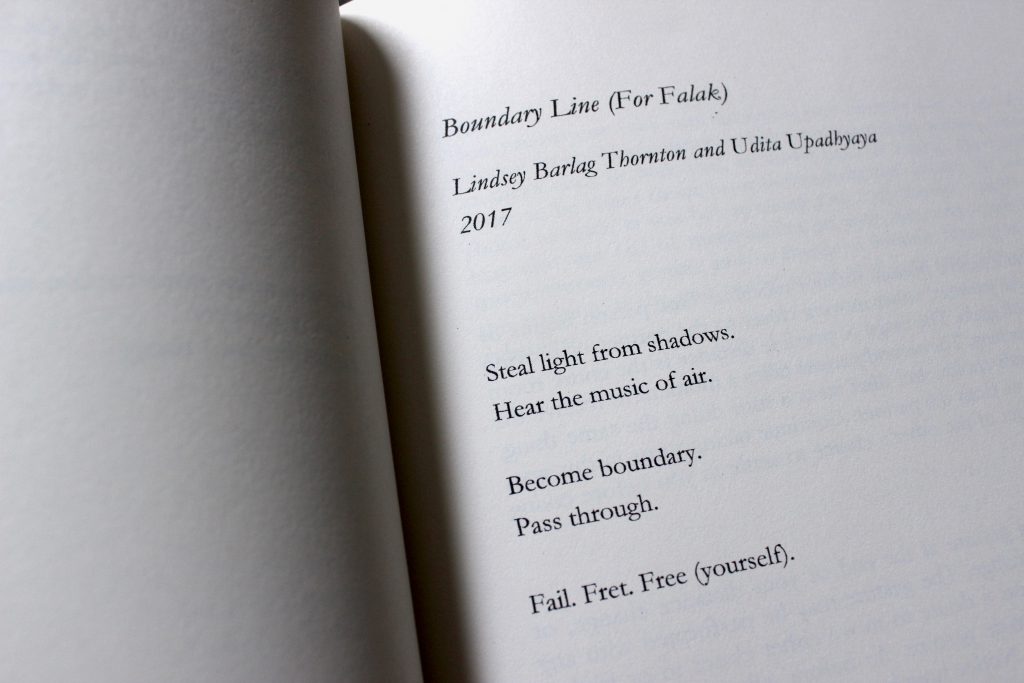
MSL: Thank you. That’s really lovely. And about the process of these: So there are 12 physical scores, that are for individual people or performance groups or performance pairs?
UU: Yeah.
MSL: And there is the work installed on the walls all around us. I have a couple of questions and I guess I’ll say them together…because I don’t know the answer! What is the relationship between these individual pieces — or “love letters” — and the work around us? Are each of the things represented on these scores represented there on the walls, or are they completely different? I’m thinking about how the space that we’re in is very public — there’s a huge window, people can see in, they can see a lot of the show. These scores do become performances but on their own they seem more private. Were you working on these individual pieces and the room-based piece concurrently? Is all of it together one piece? I guess, what are those interrelationships like — logistically, conceptually, private-public?
UU: That’s a great question. And I think part of the reason I was excited about this space was this window! And the reason I was excited was because the scores I was writing before, at that time, were what it means to be walking down the street and to be “publicly owned” — like the public ownership of female bodies. So I was and am really interested in the public-private, but with these scores they also became so intimate, which is why we’re making it a book, right? Also because they became bigger than I set out for them to be. I was like, “These can’t just be something that’s in people’s inboxes. This needs to be a whole thing!” [both laugh]
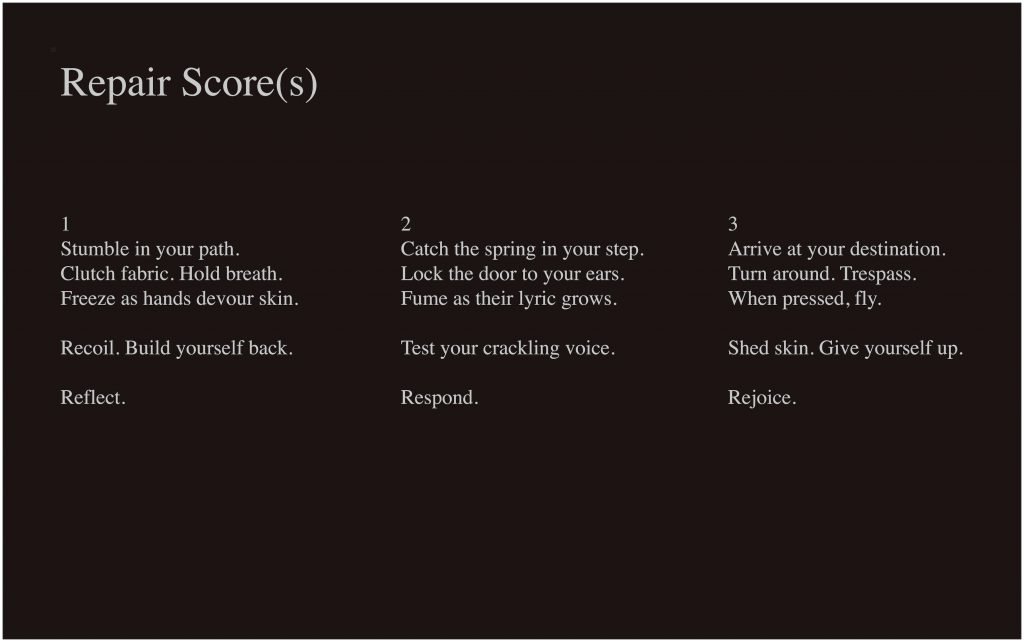
Originally one of my thoughts was to write a score for the space as a separate, thirteenth score. There are multiple reasons why that didn’t happen, and I think it’s an example of how when I try to dictate my process, I’m often wrong, rather than when I let the process dictate itself. I can get very mathematical and be like, “So, the space and the windows is a separate score in and of itself.” And then I printed all of these scores out and was like, “I have it. Now I just need to collect what I want to reveal to people who are not necessarily the ones that are being gifted the thing.” The words on the wall are still gifts. I talk about every phrase being a gift — to the self, to the other, to collaborators, to an accidental audience. So I went in and made new documents for printing on vinyl that were sections of these scores. So this [pointing to a paper score] is a shape that you see on the wall right there. This is “shake, quiver, never conquer” [points to paper], “never concur” is right here [points to wall]. They were basically a selection of what I wanted up here, even design elements. I feel like I had to recreate it. But like, the “become become become” [points to page and wall] — because it was interacting with other things it became, like, sitting also right in front of a “beginning,” which is also “be-”. So I was doing what I do on Illustrator, now on the walls here.
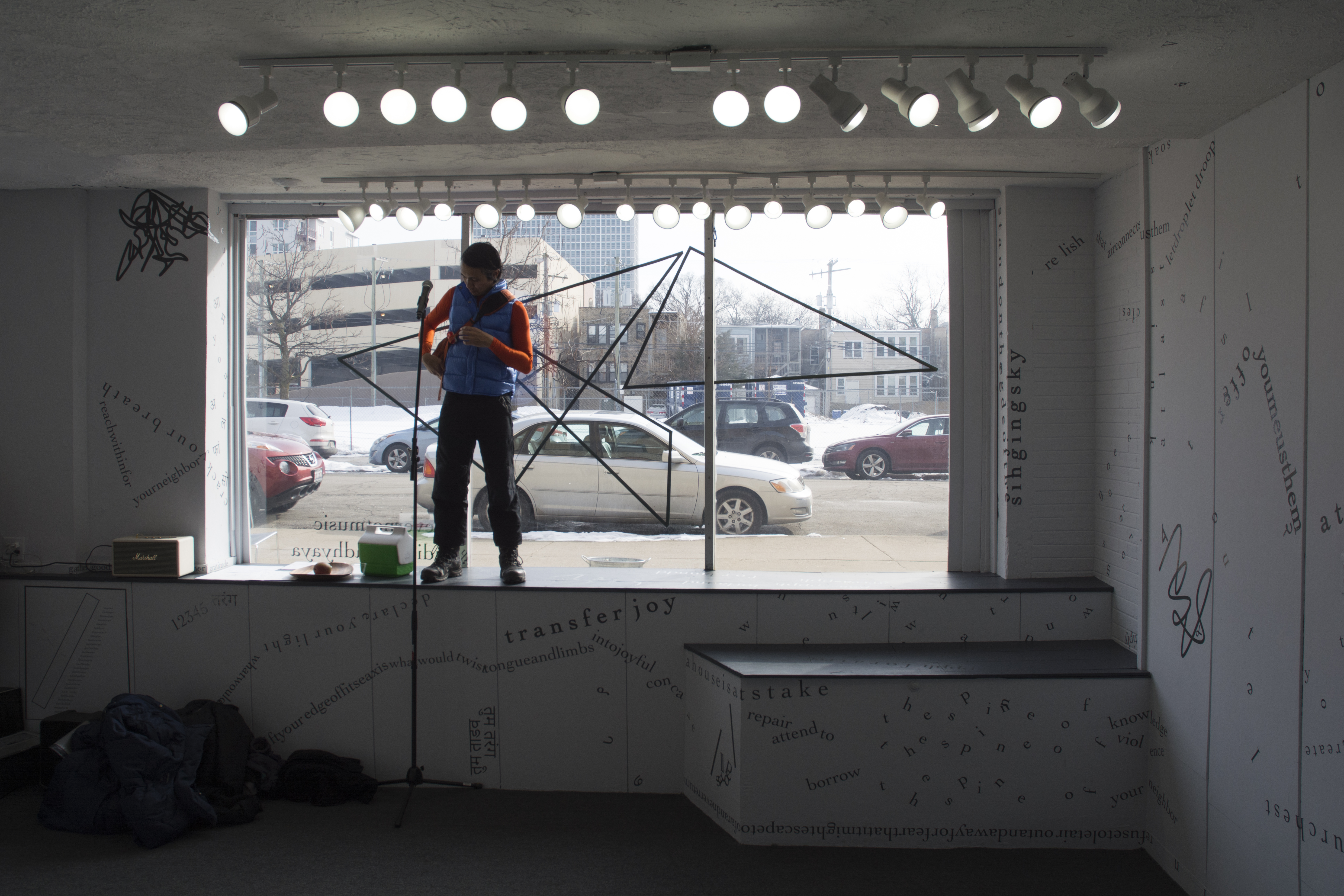
MSL: Was your process for that that every single individual score must be represented somewhere in here? And is what’s on the walls only from the scores? Or were there additional layers that you added?
UU: There are no new words that are on the walls here that are not in one of these scores. But I think it’s just because what we’re seeing around us is like one-twelfth, or one-eighteenth, of what’s actually in the scores. So the walls are one-eighteenth, maybe, of what actually exists. All of the scores are in there. I mean, there were things that I loved in all of them, so I did make sure that I took things from everything.
The process to write the scores was actually really interesting, to recognize that my brain separates text and image, but it also separates Hindi and English in this way that I didn’t really recognize it does. Like with this one [picks up a score], I wrote the entire text first and then arranged the text as visual and then was like, “Oh my god, I don’t have any Hindi in this, and what’s the Hindi that I want to give Ethan [T. Parcell]?” And I knew what it was going to be so then I found it and made it a visual. So this is the English word and the Hindi of that English word is layered on top of it. Nobody can actually read that. I’m actually surprised I remember what it is, to be quite honest. But that one is a Hindi word, that’s also played with. That’s the word, but I’ve multiplied the ti-ti-ti-ti-ti r-r-r-r-r. So it’s ti-ti-ti-ti-ti r-r-r-r-r. So I’m treating the Hindi in the same way but my brain was separating everything in these three sections — English, Hindi, and image. And in this case [holds up a different score], the image came first and then the text came, and the text was really struggling to show up. So the processes for each score were all different but all of them had these three different chapters that came with their own order that they wanted to.
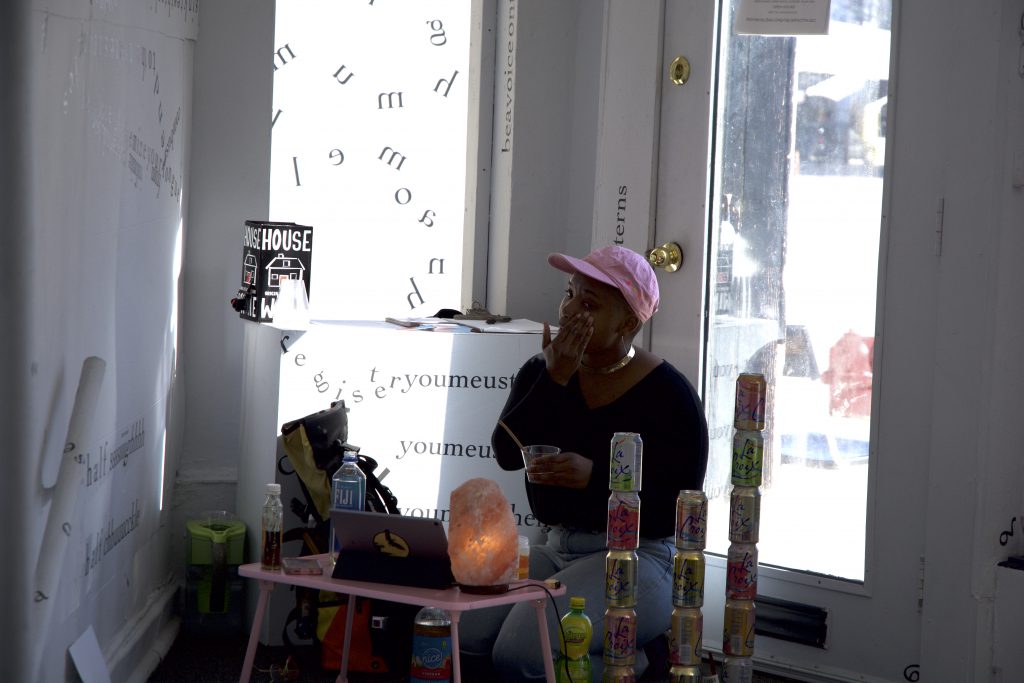
MSL: And, to back up even further, did you mention that you met with each of these performers before or as you made their scores? Did you interview them? Is it just from knowing them already that you were like, “I think they would have fun with this,” “I think this would be meaningful to them.” What was the process of figuring out the content that then becomes the score?
UU: There are a couple of performers that I didn’t know super well. Others are my closest friends. For example, since Tannaz [Motevalli] is here, I’ve known Tannaz’s practice since, like, the minute I came to Chicago. But still, Tannaz and I met a bunch of times and spoke a bunch of times, really getting at the question of “Where are you right now?” I didn’t want it to be prescriptive, even though it is instructional in some ways — like there is literally the instruction of “Cradle (youmeusthem).” But I didn’t want it to be like, “You made this work three years ago and that’s what I remember of you.” I think there were moments of that, but it was very much like, “You’re thinking about this right now, and this is something that we feel would be incredible in the space.” So I met most people in this space and then tackled, “in this space, this is the kind of work that you would want to activate, in this moment.”
Tannaz has two chapters of performance — the second Sunday and the fourth Sunday, today — so it was like, “You will have two chapters: Do you want to do two separate things or do you want to repeat the same thing a week later? Or two weeks later?” So it was specific to everyone, based on where they were at. Like Lindsey, for example — and this I know more from friendship with her — but she was just like, “I don’t know, I haven’t performed on my own in so long, I don’t know if I can do it,” and I was like, “Of course you can do it. Wait. I know when you’re going to do it!” [Marya laughs] So that ended up being more of a restriction [for Lindsey], right? Versus, for a lot of people there was no restriction. It was more like, “I know you’re thinking a lot about….”
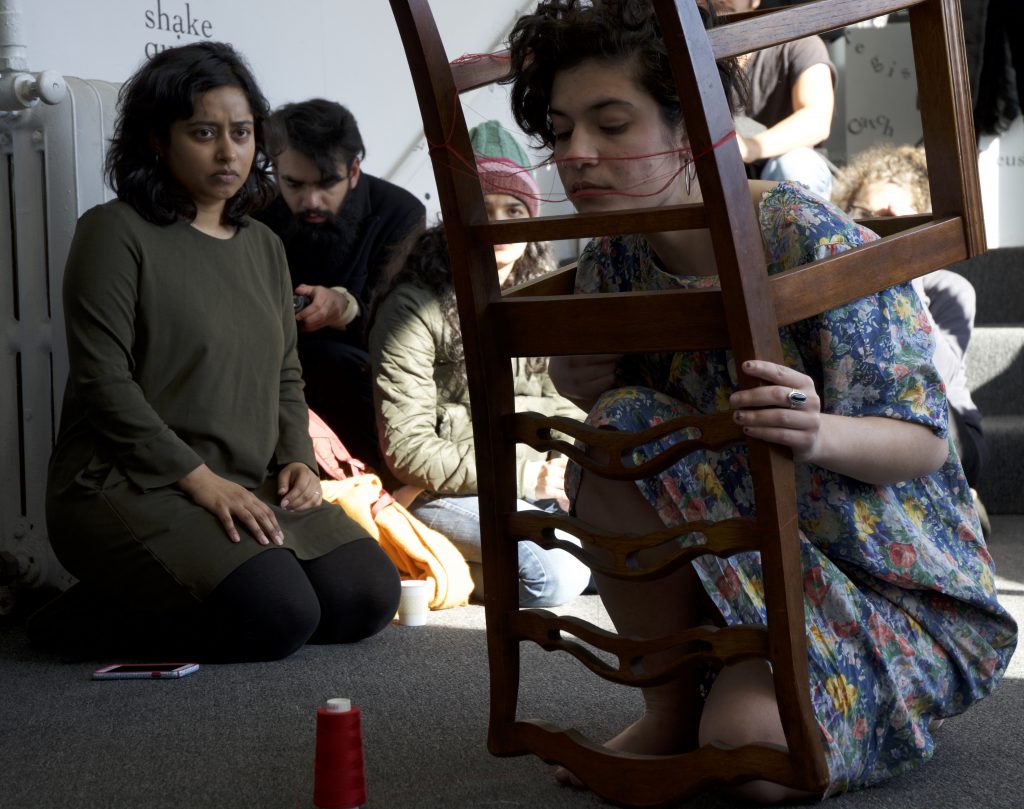
[picks up score] This is the group — Connie Noyes and Beth Bradfish — that I knew the least. And Connie had mentioned that she thinks the moment of birth and death are really similar. She had had three people die in the span of a couple of months — including her husband and her dad — a few years ago. I was really fascinated by her intimacy with this thing I think about a lot and I wanted to just give her a score to basically address that in whatever way she saw fit. And it ended up becoming a lot about our conversation. Like I’m really amused that in this score it says, “laugh at me for my lack of (in)sight.” You know, because there’s an intimacy that she has with the material of death that I don’t. So, this ended up being more of a recapping of a conversation. So the scores are pretty different in that way.
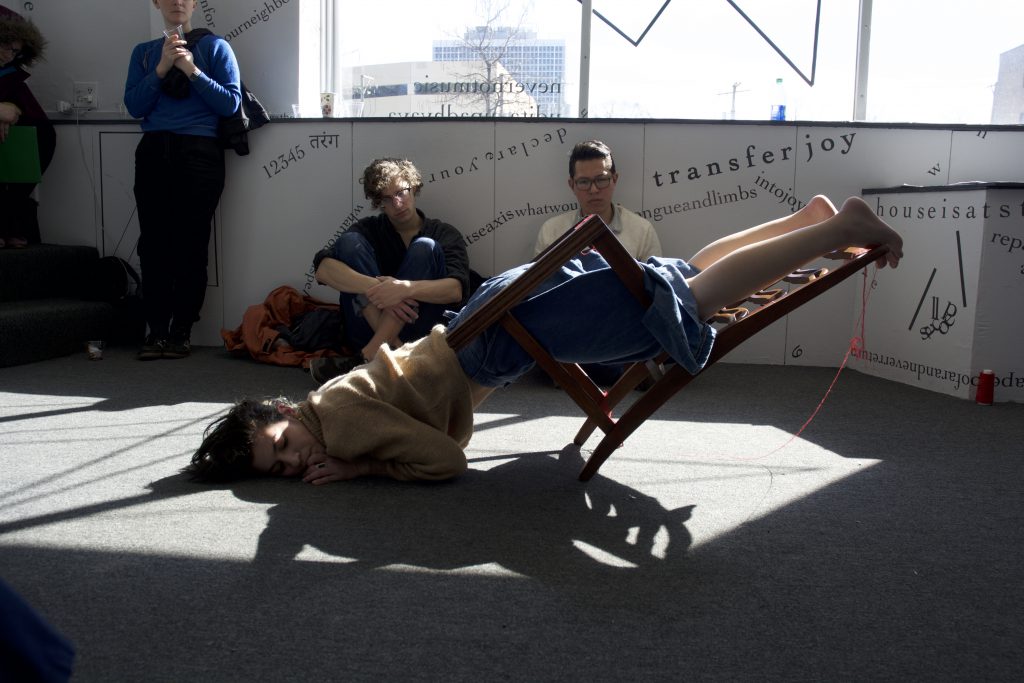
MSL: And can I ask — and I hope this doesn’t sound like a really impertinent question — but…. So, these are super personal scores, from personal conversations that become manifested in this form. And you see clips of them around the gallery but can’t necessarily look and say, “Oh, ‘a tender beginning,’ I know who that is, I know what that’s about.” And then, of course, when the performers are coming into the space and sharing themselves here, whoever’s present becomes part of that too, you know, becomes sort of the beneficiary of that intimacy and those stories in a way. I guess I’m wondering what you’re thinking about what happens when it becomes a book.
Like, when reading the scores myself, I didn’t feel like I was reading someone’s diary, necessarily, or intercepting somebody’s mail, because you shared these with me. But then also, in reading them, I felt like I was stepping into somebody else’s intimate relationship — and some of these are people that I know a little bit, but many of them I don’t, or don’t think I do. The amount of trust that people needed to have in each other in this process is really incredible and really evident, particularly in the individual scores. But it also makes me ask questions about this translation to, say, a book form, or even this interview — or to something that isn’t just the people in this space at a given time but is instead something that someone could happen upon in a bookstore or whatever you’re imagining. But, yeah, what happens to it then? As I said, I still get so much out of seeing any of these scores, maybe the same way some people love reading historical letters [laughs]. But then there’s always that really private layer to it as well.
I don’t know. I know I just said a lot, but those are some of the kinds of things that are coming to mind as I’m hearing you talk about that process and thinking about what’s happening with this work next.
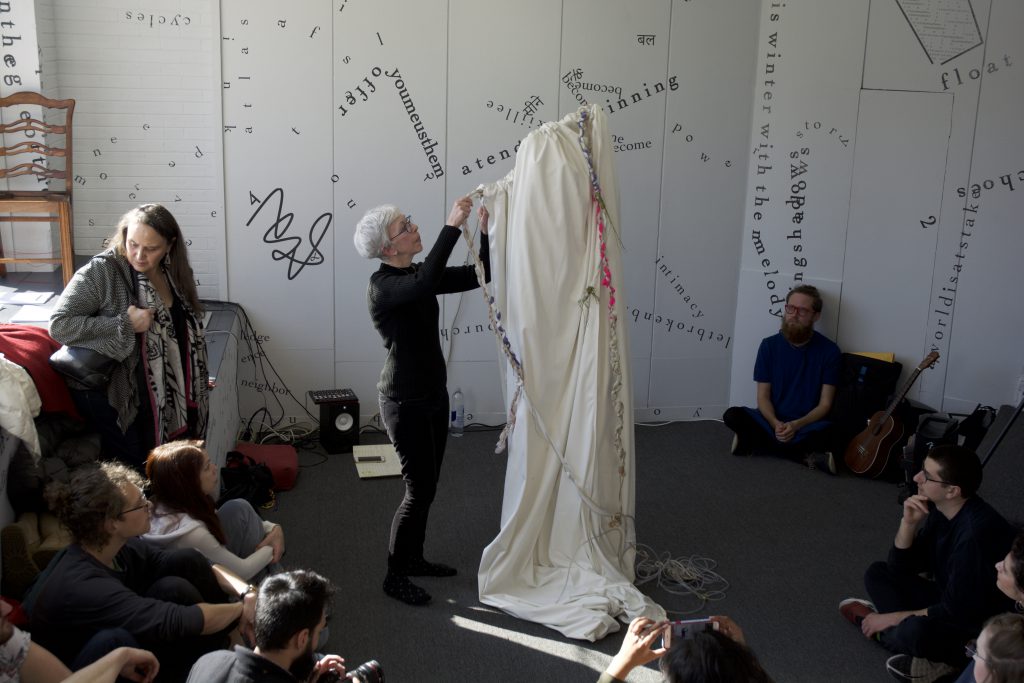
UU: Well, it’s funny. I work a lot with secrets and shame. I’ve actually been thinking about it a lot this weekend, in a way that I haven’t for a long time. And the secrets here are super worked, or maybe I mean coded. But also, everything has permission. Like Connie is very open about talking about these deaths — her practice right now is about these three moments of loss, you know? Nothing in here is something that is going to bring vulnerability that doesn’t also come with an inward shield. So I hope they are generous. I am working hard to keep them generous and not exploiting personal stories. Which I completely have done in art and all of us do anyway — simply by telling and retelling stories, but here I am taking more care, I am working to make the scores completely generous.
And to share them is the same feeling of, like, I want you to be able to insert yourself in Ethan’s place. I would never have written these words to anyone but Ethan, but that doesn’t mean they don’t also bring meaning to people that are not him. And I think if you are me or the person the score is written for, you might have a different moment with it. If Tannaz is reading Tannaz’s score and there’s a phrase in there that looks quote-unquote benign to somebody else, because of what we’ve talked about it might be like, “Oh, this is a moment of a different kind of understanding.” Like we talked about breath in a way that is not necessarily present in the word “breath” for somebody else. And I think it’s the same thing. Where they are coded, I guess, in a way.
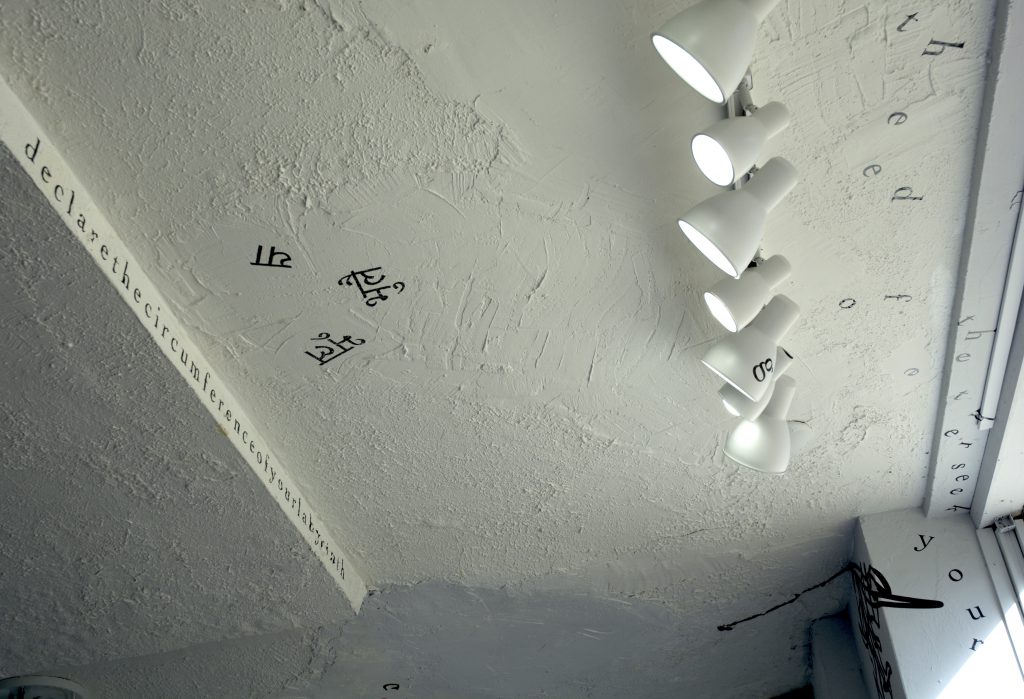
MSL: Yeah, and I didn’t mean it as a suggestion of violation of trust or anything, but it’s just that I have the feeling when reading them that if I hadn’t been invited to look at them, I would feel like I was violating trust.
UU: Yeah, and I think that is definitely something that’s interesting. I think it’s going to be present in the book form too. We’re thinking about a small edition. We don’t know exactly what number. But it’s not like you’re going to walk into whatever the version of Barnes and Noble that still exists is [both laugh] and find this book.
But at the same time I think these are things that I want people to spend time with. For me, one of the best moments was that I have a friend who knows multiple languages and is all kinds of brilliant and he was helping put up the show and he read “a tender” as “atender,” assuming it was in a different language. You know, when David is misreading the work, that’s when I’m like, “Oh, this is about literacy. This is about power” — now I’m just reading words off the wall — but this is also about power and who has the ability to never be confused with letters versus who doesn’t and how much we take that for granted. Like David or me, for example, have never struggled with being able to read and comprehend in quite the way that a lot of people do. And I think by being in this room both of us were like, “Whoa, everything feels like it is jumping off the walls, everything is confusing.” Like, I made the scores and still in the room I’d go back and be like, “I’m misreading everything now. I’m misreading the emails that are being sent to me.” And it sort of did become about access and body in a way that also caught me off-guard.
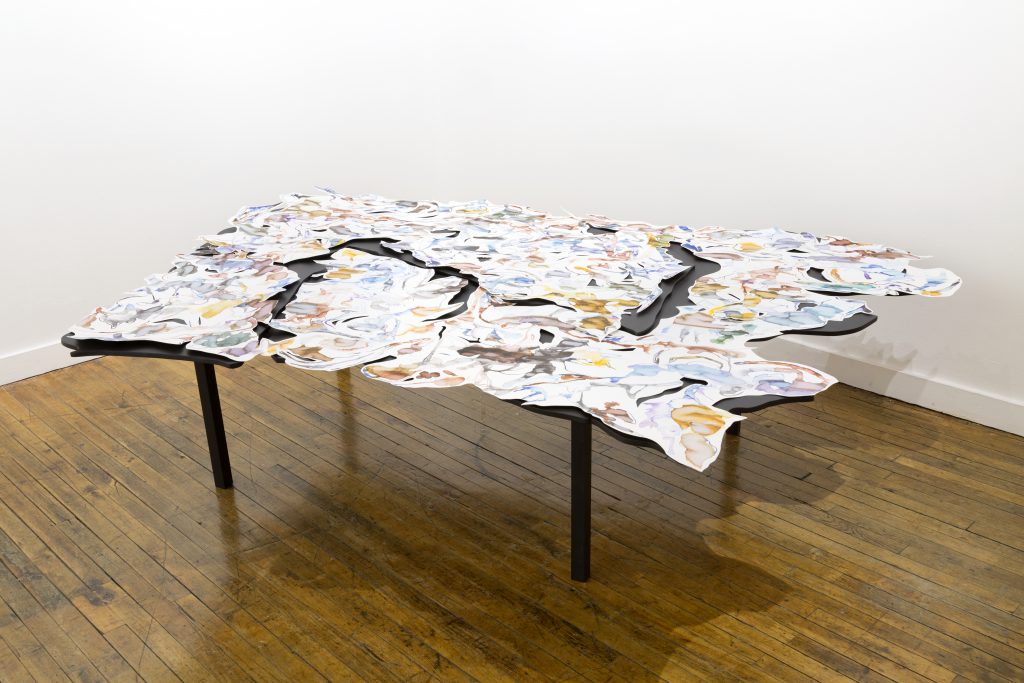
MSL: And I wouldn’t necessarily say that, in reading the scores or in looking at the walls, that the way the words are presented is quote-unquote “equalizing” or anything. But as somebody who also hasn’t traditionally had difficulty reading, in English at least, it’s seeing words either stretched out (so there’s a suspension of meaning and I’m trying to fill in the gap in my mind while also trying to find the next letter) or seeing everything so collapsed (so I have to consciously look for the word-breaks) that does make me have to pay attention to reading in a way that I don’t normally have to. I imagine it might have a similar effect on other people who also haven’t traditionally had difficulty piecing letters together to identify a word or orienting themselves in a text.
So I know the performances are going to start soon, and we’ll talk more again another time, but because we’re still in the space and because you were talking about what happens with these pieces after they leave your hands, I guess I’m wondering — if you feel comfortable talking about it with performers present — what has happened with the scores so far in the space, what delighted you, what surprised you, what did you learn? What has happened with these?
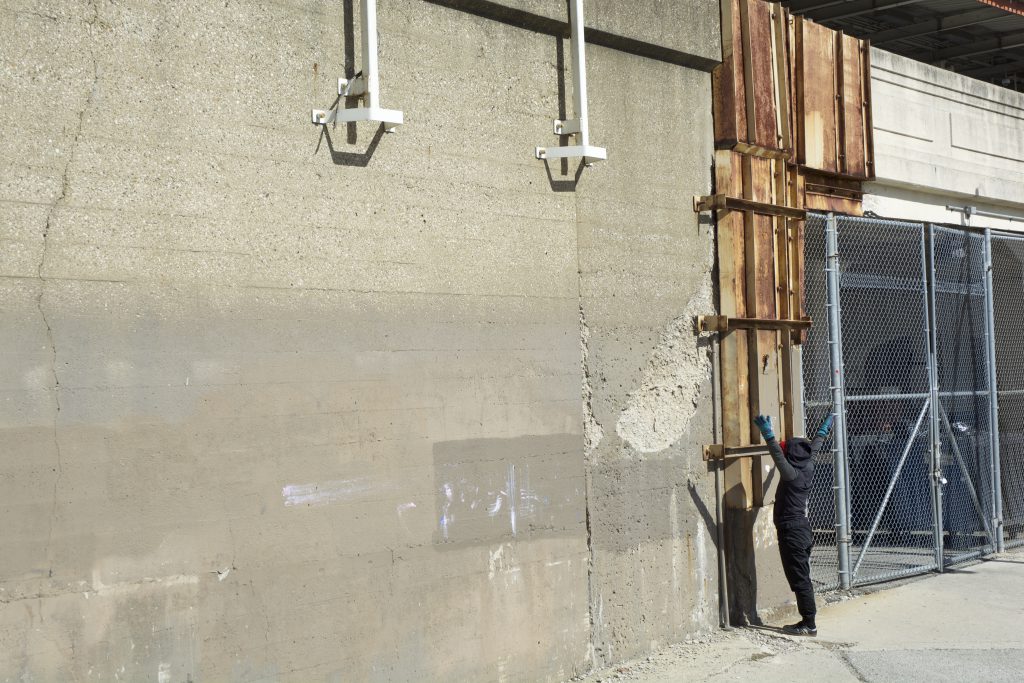
UU: Well, [looks outside] this is one of my favorite things about the space, that people will just stop as they’re passing and stare in…
MSL: [laughs] Yeah, it’s happened multiple times while we’ve been talking.
UU: Yeah, it’s a lot! Part of the show was created with that in mind. It’s been really interesting. “It’s yours now,” in a weird way. Earlier we were talking about gestation. I had the baby and had given it to someone else and I trust them. And I’m not going to interact with how they raise it or whatever. And this is kind of tangential but a lot of people — maybe, I think, all three humans in this room that are not you and me — are interested in continuing with the score. I think I can imagine Tannaz working with what she made for this piece for a long time to come. And some people have told me that. “Is it okay if I keep working with the score after the show?” And I’m like, “Yeah, it’s yours. You can come back to it.” Like Ethan has actually laminated his score. [laughs] He’s lovely. He’s also the reason the show’s called “nevernotmusic” in many ways. So this is something that in many ways is really a gift.
And in the same way there have been moments where people have not necessarily received the score at all, right? It’s been like, “What is this? I don’t get it. I was just going to show up and do what I do.” That’s been a little bit trickier, but that’s okay too. And I think that is sort of what happens when growing from four to 12 performers. It’s something I’m still negotiating with and maybe I’ll have more answers for you the next time we talk. But Corey Smith, for example, literally was sitting where we’re sitting and, like, performed his response to the score as about our relationship. He was like, “My score from Udita is ‘Unfold (into you)’” and then went on to come up with all of these things that I didn’t even realize he thought of when he thought of our relationship as friends and frequent collaborators. It was a beautiful recap of what he felt on receiving the score from me, and also mirrored what I had felt writing to him. That was a literal following of the score. Now, he’s a musician and a composer, he works with scores. That was that relationship. But there were also moments with other performers where it was like, “I don’t know, I don’t know what a score is, I don’t know what I’m supposed to do, it’s intimidating.” So it’s been a tricky balance of that.
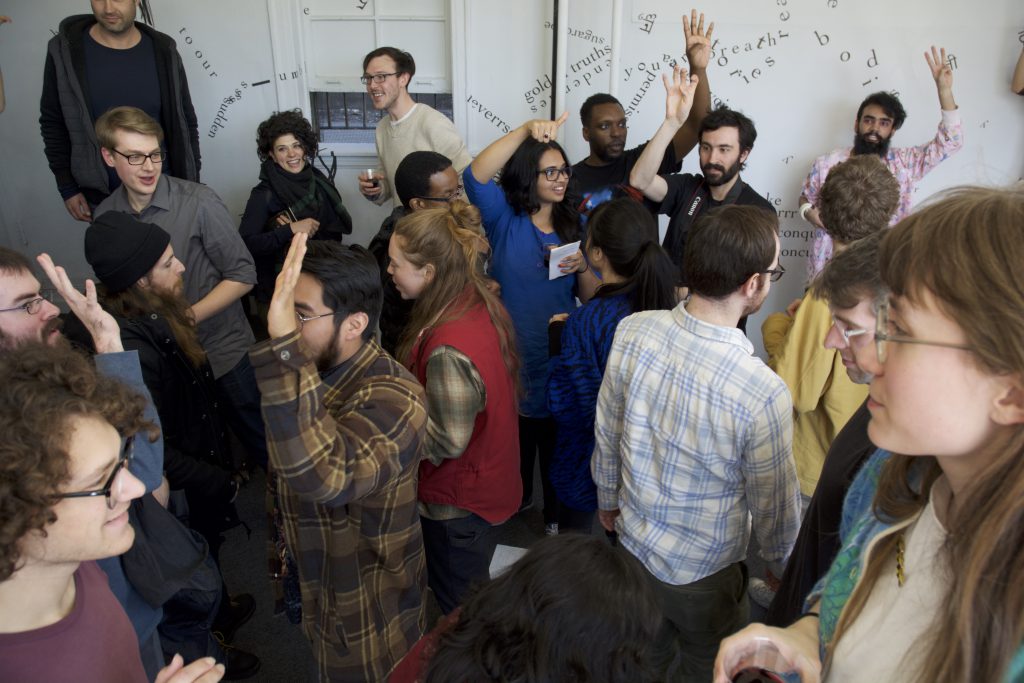
One really funny story that I will tell you is that in this score — for Will [Quam] and Kevin [Sparrow], “Witness (youmeusthem)”; we had this performed last week — there’s a sentence that says…wait, let me find it [both laugh]. Well, there’s a sentence somewhere here that says, “Leave before you’re ready.” There it is. “Dear Kevin Dear Will”…“leave before you’re ready.” And as part of their performance, they did sort of a walk-around, and their last instruction to the people walking was, “Leave before you’re ready.” So that sentence became literally something that everyone — and it was very well attended last week — repeated, “I have to leave before I’m ready! I have to leave before I’m ready!” I was like, “I knew that sentence would bite me in the butt someday and there it is right now.” And ironically, we were supposed to end at four and it was like 4:45 and everyone was “leaving before they were ready” at that point. So yeah, people are using the score even literally in moments like that.
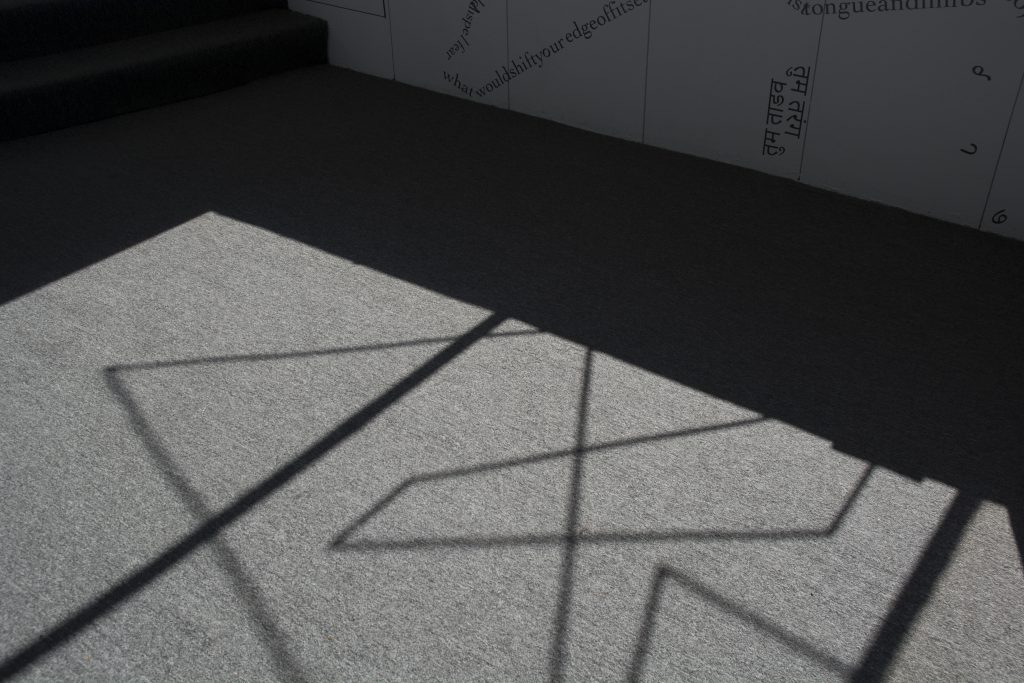
MSL: Last quick question because it seems like things are starting to happen. Why Sunday afternoons?
UU: [performatively gasps] That’s a good question…. Because of the winter, I think. It needs to be daytime. The sunlight here is beautiful. Like through the course of the time that we’re here today you’ll see beautiful shadows that happen –
MSL: It puts the score on the floor.
UU: Yeah, it puts the score on the floor. We were documenting the other day and “music” was reflected on “gratitude.” We got that image and it was just like [whispers] “What…is…happening…?” [both laugh] So I think it was more that I didn’t want it to be a nighttime thing. I think Nora Sharp is going to perform outside today, these clowns [SUCROSE] are always performing outside and getting everyone else to be frozen with them. [SUCROSE laughs and agrees] Yeah, I think it was just daytime, sun, winter. Like, when Nathan and Kristin and I met we were like, “We should do it in the winter, right? It can become about the winter.”
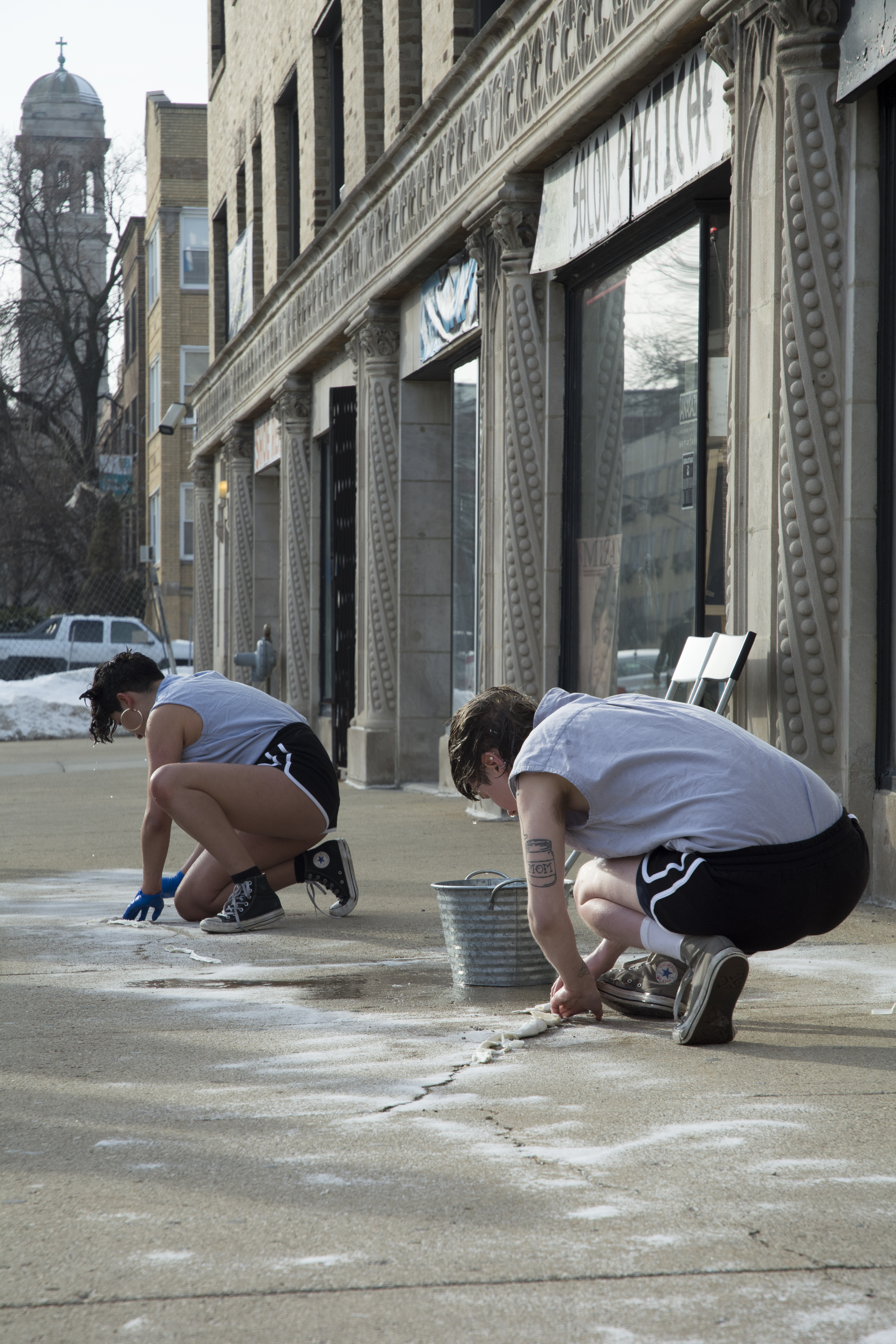
MSL: Yeah, I was wondering how much it had to do with the light, and how much it had to do with a super-consistent schedule of what’s happening, rather than being like, “And this is happening on a Thursday and this is happening on a Wednesday…” and how much that has to do with ritual in the space. But also, going to an opening on a Friday night or something, it feels like everybody’s at a stop on the way to another stop. There’s something about a Sunday afternoon, which is like, if you’re coming out and going to it, it’s because you’re coming out and going to it. You know? Because you’re going to spend time there.
UU: Yeah, yeah. I do like the word ritual because it was for consistency. Initially, because I’m me, I thought, “We’ll have 6-8 events,” and then I was like, “Four’s a lot.” Because I literally at one point was like, “I will have to go to them!” [laughs] And I want to hide on the weekend too. I mean, it sometimes feels like we’re asking a lot to be here for two hours, but people have stayed and then they’ve stayed after and then they’ve come back the next week because the space is so intimate and what we’re working with is super intimate. Like, last week, there were people crying because of how Falak’s performance was and falling in love with Falak because of their performance. It was just really lovely. It kind of also feels like the “family” day or the day for community. We always have chocolate! We’ve had self-care chocolate — literally we’ve been calling it that — and have been going around with it every Sunday. It’s been cute.
MSL: Awesome. Thank you! I guess, to be continued.
UU: [whispers] To be continued…
Featured image: The photograph shows the artist at center, standing in front of one of the gallery’s internal, white walls, with performers and guests sitting or standing on either side of her. Black vinyl letters are installed directly onto the walls, in the form of words and phrases in English and Hindi. Text appears in different sizes and spatial orientations (e.g., right-side up, upside-down, diagonal, vertical, and organic shapes), with some words/phrases expanded in space, condensed, or intersecting with other text. English words/phrases shown in this image include “a tender beginning,” “offer,” and “of this winter.” A gestural drawing — also made of black vinyl — is shown on the left-hand side of the image. Photo by Esther Espino.

 Marya Spont-Lemus (she/her/hers/Ms.) is a fiction writer, interdisciplinary artist, and educator focused on teen creative, leadership, and professional development. She lives and works on the Southwest Side of Chicago. Follow her on Twitter and Tumblr.
Marya Spont-Lemus (she/her/hers/Ms.) is a fiction writer, interdisciplinary artist, and educator focused on teen creative, leadership, and professional development. She lives and works on the Southwest Side of Chicago. Follow her on Twitter and Tumblr.
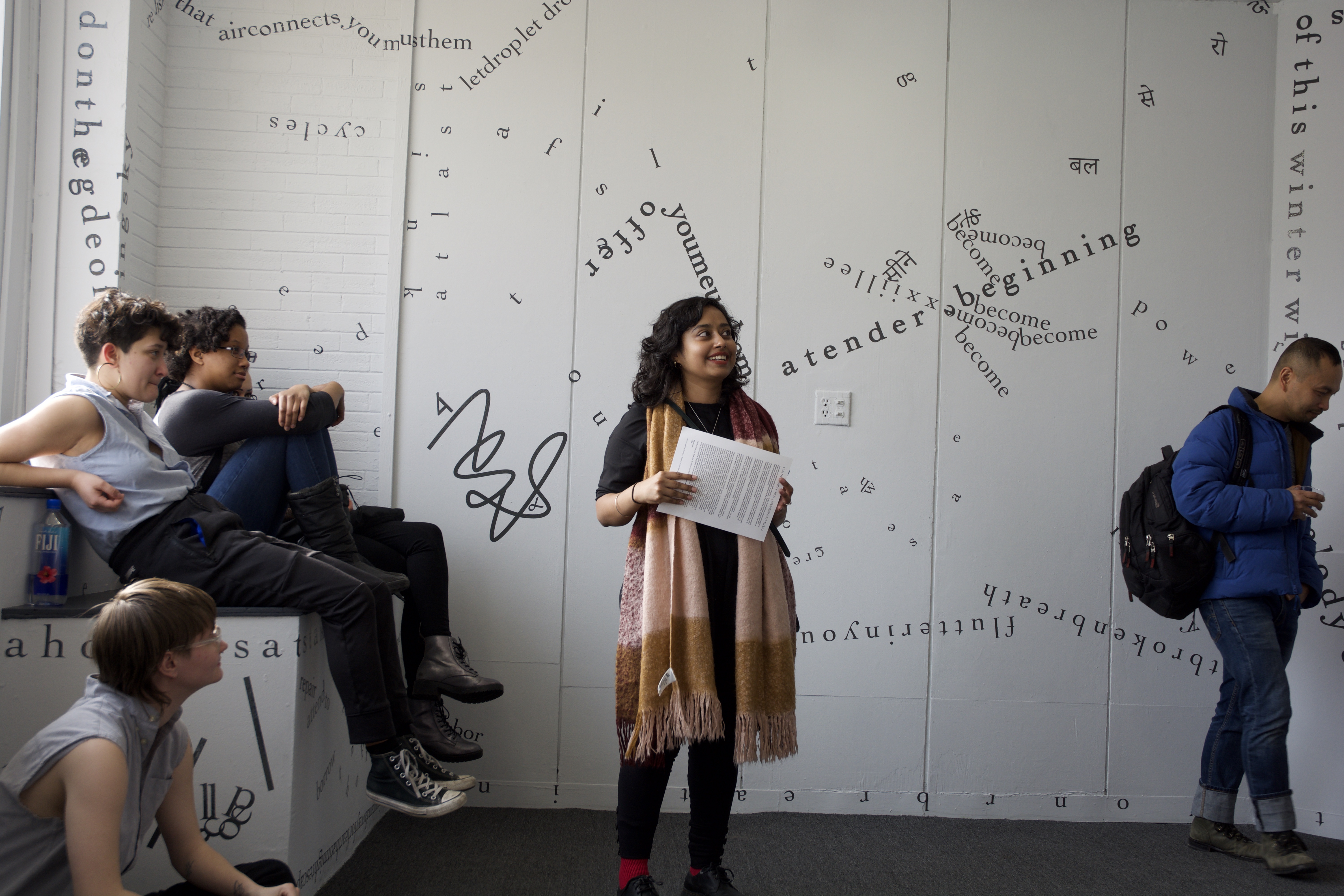
![[placeholder image]](https://sixtyinchesfromcenter.org/wp-content/uploads/2020/12/Quenna-Lené-Barrett_Headshot-300x99.png)
